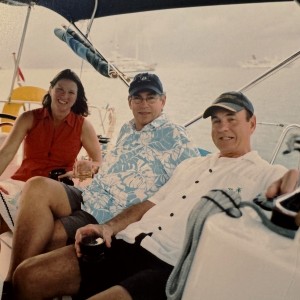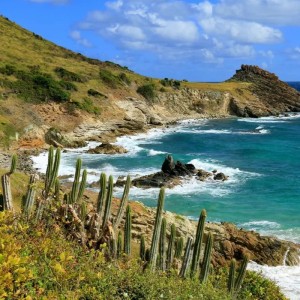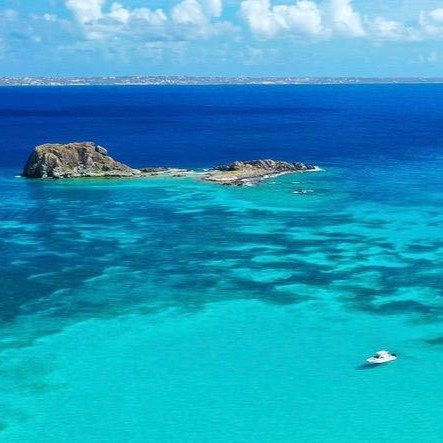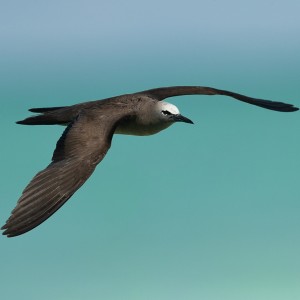All set for a wonderful sailing adventure out of St Martin, weather intervened and it was not to be.
In September 2017, Hurricane Irma hit St Martin/St Maarten with devastating force. The scenically beautiful Caribbean island is split between the French side in the North, centred around Marigot, and the Dutch side in the South, where the capital is Phillipsburg. It’s the smallest territory in the world to be shared between two nations. Just as the island was beginning to recover from the hurricane, when we started thinking of re-scheduling our charter with our sailing friends, the pandemic hit and once again plans were put on hold.

I have very happy memories of many trips to the island. One of my early charter experiences with my friend, known as Captain Bligh, was out of Sunsail at their original base in Oyster Pond, on the Atlantic side. The Captain decided I was the most experience sailor on board and put me at the helm for the departure from the base through a narrow gap. A Sunsail Zodiac raced alongside us. “Keep the boat in the middle of the channel,” shouted the local pilot, “And keep the revs over three-and-a-half thousand.” Under power, the rev counter is more relevant that the knot meter. From flat glassy calm one minute, to the turbulence of the cut the next, with jagged corals threatening us on either side, we were into a strong breeze off the Atlantic and a huge swell, with waves up to 15 feet high.
This unexpectedly thrilling start to our weeklong adventure tested my equanimity, but my chums on the crew quickly got the sails hoisted and we were calmly cruising along the top of the swell towards our first stop at Tintamarre Island for a first swim of the trip. Our evening destination was Anguilla. That story for another day.
Now the Sunsail base, shared with The Moorings and both owned by Tui, is located in the much calmer waters on the Caribbean side at Marina Fort Luis in Marigot. Unfortunately, since my beloved Diane has left us for the big pond in the sky, the impetus to bare boat charter has left me and I prefer a quieter trip exploring parts of the island that previous nautical experiences had left uncharted.

On a recent visit, I had several days to visit and wander in the St Martin Nature Reserve.
This is a wonderful example of environmental protection done right. Sited on the north-east coast of the French side of the island, it consists of more than 7,500 acres and amost seven miles of coastline, set aside nearly 30 years ago to protect coral reefs, mangroves, seagrass beds, wetland ponds, salt flats and the coastal forest. It includes several small islands. Discovery trails are laid out for the more energetic visitor.
In the coastal waters, coral provides habitat for dozens of kinds of colourful reef fish, while the seagrass shelters and feeds numerous species. The reefs have the added advantage of protecting the coastline from ocean swells. Though I didn’t see any, humpback whales and bottlenose dolphins can often be spotted on the Atlantic side between the French Quarter and Oyster Pond.
Equally important to the Nature Reserve, where I strolled along meandering paths, are the ponds and mangroves where two ecosystems overlap. Large stretches of shallow water blend into dense forests protected by mangroves. They prevent the forests from being flooded during the rainy season, filtering and purifying the waters.
The reserve is a birder’s paradise, with avians both large and small drawn to the thick foliage. Hummingbirds, bananaquits, kingbirds, terns, shearwaters and egrets share the habitat in harmony. Pelicans fish everywhere. Occasionally rarer birds passing through on their migrations north and south can be spotted by those with eagle eyes – and luck.
Trees that were once native to Africa have established themselves in the dry forest. Tamarind, mango, flamboyant, kapok, red gum and guava berry all flourish, alongside beautiful wild orchids, hibiscus and aloe. Great southern white butterflies dart around looking like snowflakes. On the Froussards footpath, between Anse Marcel and Grand Cayes beach, I hiked through the last intact coastal forest on the island. It’s supposed to take about two and a half hours, but with plenty of stops to admire the view, it took me all morning.

Creole Rock, one of St. Martin’s great landmarks, is reserved for the birds which nest there. Visitors are encouraged to tie onto any of the official moorings. Some are reserved for dive clubs, while others are set aside for boats up to 50 feet, or dinghies and small sailboats. Using the correct mooring is critical to avoid harming the environment. Once moored, beginners and advanced divers can take advantage of one of the best dive spots in St Martin. The shallow waters make it perfect for beginners, with or without air tanks. However, engines cannot be used within 100 feet of the beach and visitors cannot go ashore.
A few hundred feet offshore from the excitement of Orient Bay Beach lies the secluded islet of Green Cay. It’s renowned for its outstanding corals and multitudes of reef fish, where everyone from beginners to advanced divers can expect to see nature at its best. One might even spot a turtle.
Another dry forest grows on Pinel Island, where a footpath connects the island’s three beaches. Well-organized signs and plaques tell the story of local plants and birds. Access can be made by shuttle boat from Cul-de-Sac, others make the easy trip across the water by paddleboard or kayak. Two restaurants delight with their culinary offerings of Caribbean specialties and refreshing cold drinks. Some head for the Yellow Beach, which is more like a burger bar than its more upscale competitor, Le Karibuni, where I’ve enjoyed a memorable feast and a lazy afternoon in a reserved sun chair.

The sandy beaches and shallow calm waters on the land side make for excellent snorkelling. Matching the land-based discovery trails, an underwater route has been laid out to allow snorkellers to observe amazing fish and corals without damaging them. Leatherback and green turtles can often be seen, though my turtle encounter was with a very small creature. He seemed friendy and swam right up to my face plate. By contrast to the calm of the land side, only a 10-minute walk along the beach, Atlantic waves crash dramatically ashore. At sunset, everyone leaves and only the iguanas and hermit crabs scurry around.
Further out to sea is the uninhabited island of Tintamarre, where crystal clear waters make one want to dive in immediately after tying off at one of the 17 permanent yellow moorings. This is exactly what we all did on our first charter to the place. There’s a soft white sandy beach and excellent snorkelling. An abandoned airstrip and some wrecked small planes dot the centre of the island. We were careful not to disturb the endangered brown noddy, which nests here. Someone in our party reminded me that ‘Noddy’ was my childhood nickname, so Noddy I remained for the rest of our voyage. These days I refuse to answer to it.
As I write these words, I am days away from another grand sailing adventure, this time in the Mediterranean on a tall ship. I’ll detail the experiences from that trip soon.

NOTE: A version of my story has also appeared in Forbes Magazine.
Please LIKE this blog, if you have enjoyed the article, or add a COMMENT — clickable at the top of each story. Click on the SUBSCRIBE button below if you would like to receive email notifications of new articles.
This is Nigel’s 417th blog on Gentleman’s Portion. The SEARCH function at the top works really well if you want to look back and see some of his previous stories, or check under CATEGORIES.
Categories: Adventures
